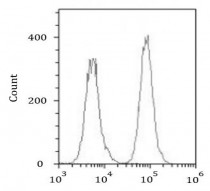ARG40917
anti-IGFBP4 antibody
anti-IGFBP4 antibody for Flow cytometry,Western blot and Human,Mouse,Rat
Overview
| Product Description | Rabbit Polyclonal antibody recognizes IGFBP4 |
|---|---|
| Tested Reactivity | Hu, Ms, Rat |
| Predict Reactivity | Bov, Pig |
| Tested Application | FACS, WB |
| Host | Rabbit |
| Clonality | Polyclonal |
| Isotype | IgG |
| Target Name | IGFBP4 |
| Antigen Species | Human |
| Immunogen | KLH-conjugated synthetic peptide corresponding to aa. 66-92 of Human IGFBP4. |
| Conjugation | Un-conjugated |
| Alternate Names | IBP4; IBP-4; IGFBP-4; Insulin-like growth factor-binding protein 4; HT29-IGFBP; IGF-binding protein 4; BP-4 |
Application Instructions
| Application Suggestion |
|
||||||
|---|---|---|---|---|---|---|---|
| Application Note | * The dilutions indicate recommended starting dilutions and the optimal dilutions or concentrations should be determined by the scientist. | ||||||
| Observed Size | 28 kDa |
Properties
| Form | Liquid |
|---|---|
| Purification | Purification with Protein A and immunogen peptide. |
| Buffer | PBS and 0.09% (W/V) Sodium azide. |
| Preservative | 0.09% (W/V) Sodium azide. |
| Storage Instruction | For continuous use, store undiluted antibody at 2-8°C for up to a week. For long-term storage, aliquot and store at -20°C or below. Storage in frost free freezers is not recommended. Avoid repeated freeze/thaw cycles. Suggest spin the vial prior to opening. The antibody solution should be gently mixed before use. |
| Note | For laboratory research only, not for drug, diagnostic or other use. |
Bioinformation
| Database Links | |
|---|---|
| Gene Symbol | IGFBP4 |
| Gene Full Name | insulin-like growth factor binding protein 4 |
| Background | This gene is a member of the insulin-like growth factor binding protein (IGFBP) family and encodes a protein with an IGFBP domain and a thyroglobulin type-I domain. The protein binds both insulin-like growth factors (IGFs) I and II and circulates in the plasma in both glycosylated and non-glycosylated forms. Binding of this protein prolongs the half-life of the IGFs and alters their interaction with cell surface receptors. [provided by RefSeq, Jul 2008] |
| Function | IGF-binding proteins prolong the half-life of the IGFs and have been shown to either inhibit or stimulate the growth promoting effects of the IGFs on cell culture. They alter the interaction of IGFs with their cell surface receptors. [UniProt] |
| Cellular Localization | Secreted. [UniProt] |
| Calculated MW | 28 kDa |
Images (2) Click the Picture to Zoom In
-
ARG40917 anti-IGFBP4 antibody WB image
Western blot: 20 µg of Mouse ovary lysate stained with ARG40917 anti-IGFBP4 antibody at 1:2000 dilution.
-
ARG40917 anti-IGFBP4 antibody FACS image
Flow Cytometry: A549 cells were fixed with 2% paraformaldehyde (10 min) and then permeabilized with 90% methanol for 10 min. The cells were then incubated in 2% BSA to block non-specific protein-protein interactions followed by ARG40917 anti-IGFBP4 antibody (green) at 1:25 dilution for 60 min at 37°C, followed by incubation with DyLight®488 labelled secondary antibody. Isotype control antibody (blue) was Rabbit IgG1 (1 ug/10^6 cells) used under the same conditions. Acquisition of >10000 events was performed.







